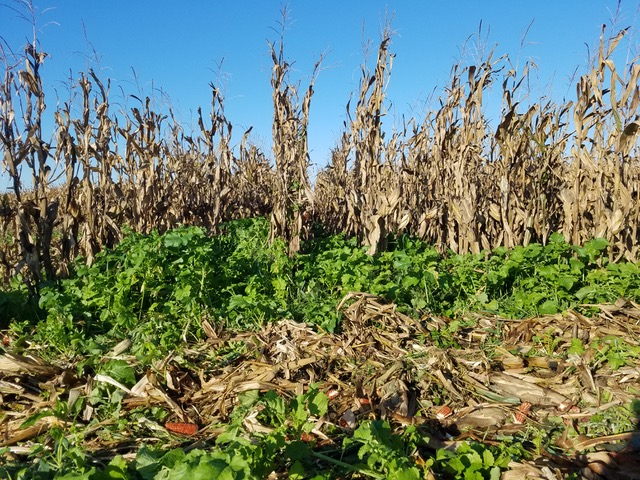Cropping/Rotation Plans
Corn and Soybeans
Mustard cover crops are new in corn and soybean rotations, but university and in-field research is underway. We recommend the following protocol:
Corn → Mighty Mustard®️ → Soybean:
- Seed Mighty Mustard®️ into standing corn OR after corn harvest. Cooler temperatures slow the rate of growth for mustards, which winterkill at sustained temperatures of 26 degrees Fahrenheit. For optimal biofumigation, plant Mighty Mustard®️ 4-6 weeks before first killing frost.
- Terminate mustard: Chop, incorporate & wait three weeks before planting next crop.
OR allow mustard to winterkill, then chop & incorporate in spring. - Seed spring soybeans (or successive crop) and continue crop rotation.
Soybean → Mighty Mustard®️ → Corn
- Seed Mighty Mustard®️ in fall, preferably before Oct. 1. Cooler temperatures slow the rate of growth for mustards, which winterkill at sustained temperatures of 26 degrees Fahrenheit. For optimal biofumigation, plant Mighty Mustard®️ 4-6 weeks before first killing frost.
- Chop & incorporate before frost or allow it to winterkill, then chop and incorporate in spring.
- Seed spring corn (or successive crop) and continue crop rotation.
- NOTE: Always check herbicide plant-back restrictions to ensure that your cover crop won’t be adversely affected.
Planting & Termination Guidelines
Nematode Suppression Protocol
GROWER PROFILE:
Illinois Grower Tests Mighty Mustard® in Standing Corn Crop
Mighty Mustard® is proven to:

Reduce nutrient runoff

Improve overall soil health

Scavenge leftover Nitrogen
Suppress Columbia root-knot nematodes (Meloidogyne chitwoodi) and other types of nematodes
Suppress soilborne pathogens: Verticillium wilt, Verticillium dahlia, Rhizoctonia and sclerotina
Suppress germination of broadleaf weeds

Scavenge excess nutrients

Reduce soil compaction

Increase active Soil Organic Matter

Sequester carbon

Prevent soil erosion

Retain soil moisture
Growing Mighty Mustard®️ to Suppress Soybean Cyst Nematodes (SCN)
According to Dr. Marisol Berti of North Dakota State University, mustard is “not a host for SCN, meaning the nematode won’t reproduce on it.”
Recently published research information by Acharya, et al., 2019 indicates that Mighty Mustard®️ Kodiak decreased SCN in greenhouse trials but results in the field are not yet clear. According to the study, “Brown mustard and winter camelina reduced the SCN populations by an average of 51% and 48%, respectively… Further understanding the effects of these crops on SCN populations under natural field conditions is needed to determine if cover crops can be used for sustainable SCN management in SCN-infested soybean fields.”

Photo courtesy of Trenton Carley of Full Throttle Ag Services.
How to help Mighty Mustard®️ succeed in your Corn & Soybean cropping system:

1. Determine your primary goal:
Do you want to reduce nematodes? Suppress weeds? Increase soil organic matter?

2. Choose the Mighty Mustard® that targets your objective:
Picking the right primary glucosinolates makes all the difference.
- For a 3-in-1 punch that reduces weeds, soilborne pathogens and nematodes, plant Trifecta Power Blend™.
- If suppression of nematodes and soilborne pathogens is your primary goal, choose Kodiak, Pacific Gold or Trifecta Power Blend™. If weed suppression if your objective, choose White Gold.
| Trifecta Power Blend | Kodiak | White Gold | Pacific Gold | |
|---|---|---|---|---|
| Reduces nematodes | ||||
| Suppresses soilborne pathogens | ||||
| Targets broadleaf weeds | ||||
| Tests negative for black rot and blackleg | ||||
| Scavenges nutrients | ||||
| Produces high biomass | ||||
| Recycles nutrients | ||||
| Sequesters carbon | ||||
| Builds soil organic matter | ||||
| Reduces nutrient runoff | ||||
| Improves soil aeration | ||||
| Improves water penetration | ||||
| Reduces wind & water erosion | ||||
| Attracts pollinators | ||||
| Grows quickly |

Fully Effective

Partially Effective

Not Effective

3. Plant:
Time the seeding to ensure maximum biomass production, preferably in early spring or late fall. Mustards are day-length sensitive and will winter-kill at sustained temperatures of 26 degrees Fahrenheit or colder.

4. Chop and incorporate:
Chop, incorporate and irrigate in one day to ensure speedy release of short-lived glucosinolates into soil.

5. Rest:
Wait three weeks before planting next crop.
How-to Video: Maximizing mustard cover crop biofumigation potential.
Video courtesy of Michigan State University

Cover crop tips for corn & soybean production:
- According to University of Nebraska, “Cover crops grown after corn and before soybean (SCS) had the highest overall biomass production at each location, as cover crops were terminated two to three weeks later.”
- According to Purdue Extension: “Plant a low carbon:nitrogen (C:N) cover crop mix after soybean and before corn. The cover crops you plant before corn should scavenge N in the fall but not tie up N the following season when the corn needs it.”
- From Midwest Cover Crops Council: “If you’re planting before soybeans, use winter cereals. If you’re planting after soybeans and before corn, use spring small grains or other cover crop species that will die over the winter (winter kill). Winter-killed cover crops before corn allow for earlier corn planting. Because soybeans are normally planted later than corn, you have more time to let a cover crop that overwinters grow in the spring before terminating it before soybean planting.”
- According to The Ohio State University:
Timing: “After late soybeans going to corn, a legume or brassica is generally the best option. However, most of these cover crops need to be seeded by October 1st.”
Seeding: “Broadcast seeding or flying on seed before harvest is the best option. Increase seeding rates by 10-20% and at least 1 inch of rain is necessary for good germination and growth. Small seeded cover crops like radish, crimson clover and oats (Buckeye mix) have been successful.” - “Reducing nutrient runoff with cover crops,” by Successful Farming. “When you get a good cover crop established, it reduces nitrate loss out the bottom of the root zone and into tile drains,” says Eileen Kladivko, Purdue University agronomist and cofounder of the Midwest Cover Crops Council.
- Controlling Soil-Borne Disease in Soybean with a Mustard Cover Crop: Kansas State University Extension
- Residual Herbicides and Fall Cover Crop Establishment: Purdue University
- Crop Rotation with Cover Crops: Sustainable Agriculture Research & Education
- Potential and Limitations of Cover Crops, Living Mulches and Perennials to Reduce Nutrient Losses to Water Sources from Agricultural Fields: Environmental Protection Agency
Mighty Mustard®️ tips for corn & soybean production:
- According to Washington State University, fall incorporation is most effective for suppressing nematodes and soilborne diseases.
- Choose the right glucosinolates for the job: White Gold for weed suppression; Kodiak or Pacific Gold to suppress some nematodes and soilborne pathogens.
- Researchers recommend using mustard cover crops to enhance, not replace chemical treatments for nematodes.
- Time the planting to ensure maximum biomass production, preferably in early spring or late fall when daylight hours are shorter. Increased biomass is key to improving biofumigation results through increased availability of glucosinolates and organic matter.
- The biofumigation action of glucosinolates is short-lived, so it’s crucial to chop, incorporate and irrigate the Mighty Mustard®️ green material in one day. Leaving a trash layer of dried mustard on top of the soil will diminish biofumigation impact and decrease effectiveness of nematode suppression.
New to cover cropping?
Cover Crops Research Library
Helpful research links for cover crop management in corn & soybean systems:

